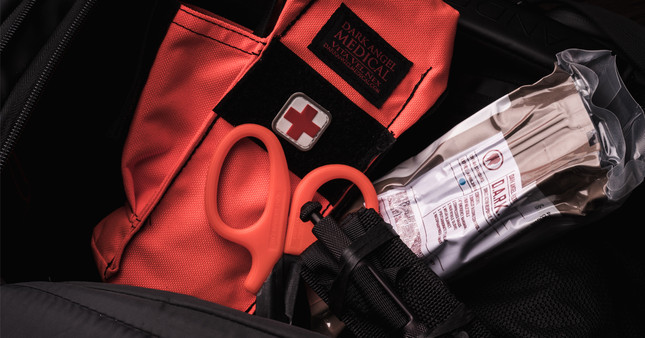First Aid Kit or Trauma Kit?
Apr 16th 2018 Kerry "Pocket Doc" Davis

Is it a first aid or a trauma kit? OR…..is it both? The correct answer is that it should be either one or the other and that you should know, both, the differences AND the limitations of each. A first aid kit isn’t a trauma kit, though it can have some traumatic care items in it, and a trauma kit isn’t a first aid kit, by our definition. So, which is which? I’m glad you asked that question. Lemme ‘splain you….
Having a first aid kit is just as essential as having a trauma kit because they both fill very specific roles. First Aid is what is done immediately after recognition of a sudden illness or injury and can, indeed, be lifesaving depending on what actions need to be taken and what items are on hand. What we want to do is try to separate “First Aid” from “Trauma” and clearly delineate what they are in our line of work. First Aid, to us, is more minor, non-life-threatening injuries, our “boo boos” while trauma is some type of injury which requires immediate actions to be taken in order to preserve life.
We try to separate our kits like that as well. A very comprehensive first aid kit can have some life-saving components in it and that’s cool, but know where they are because in the first instance of trauma, it’ll become a tactical yard sale as crap is being strewn in every direction while that “one” item is being sought out. A comprehensive first aid kit, while nice to have, tends to be on the rather large side, which is another reason we like to keep things smaller, more compact and easier to carry. The smaller, more compact and easier it is to carry, the more likely you are to carry it where it belongs; on your person.
A trauma kit has the basic necessities to help with the things that will kill us the quickest, the first being massive life-threatening hemorrhage. At a bare minimum, you need to have a pair of gloves (non-latex due to latex allergies) to protect you from body fluid-borne pathogens and a PROVEN tourniquet, not the latest “cool guy” tourniquet or a frickin’ knock off from China. Next, you should have some sort of hemostatic gauze like QuikClot Bleeding Control Dressing or a chitosan-based product like ChitoGauze along with a pressure dressing to reinforce the hemostatic agent and hold it in place. Those are literally the basic foundations of a “trauma” kit. If you can, add a pair of compact chest seals in there as well so that you have the ability to “stop the bleeding and start the breathing”.
What your first aid or trauma kit doesn’t need in them unless you are trained AND certified to use them: Suture kits, chest decompression needles, surgical airway kits, chest tube kits, endotracheal tubes or any other advanced, invasive procedure devices. Why? They are a HUGE liability and they take up valuable space that could be occupied with more pertinent devices like tourniquets and hemostatic gauze. I’ve yet to hear of a major trauma victim needing to be sewn up in the field at the site of the injury. Any of the other stuff I mentioned, unless you’re an MD, NP or PA, stay away from it. I don’t care if you watched it on YouTube or took a TCCC class, unless you have those licenses you CANNOT legally perform those procedures and even if you’re a CCEMTP or Flight Paramedic, you can’t perform them unless you’re under direct medical control.
Basically, keep your first aid kits limited to first aid situations and your trauma kit limited to trauma situations. That clear delineation will greatly increase your chances of finding what you need should the situation arise. Only place items in them with which you have been trained on or you are otherwise certified to use. Stick to the basics of trauma management; “Stop the bleeding and start the breathing” and everything else will fall into place.
https://darkangelmedical.com/blog/first-aid-kit-or-trauma-kit/?mc_cid=8bdc3fb1b9&mc_eid=a1d5137709



















































